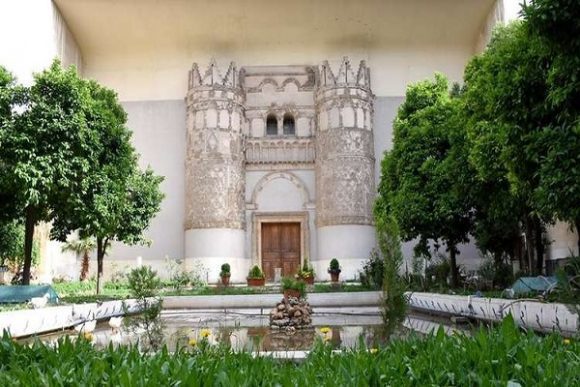 The National Museum of Damascus
The National Museum of Damascus


The story of the National Museum of Damascus dates back to the beginning of the 20th century, when a group of Syrian intellectuals expressed their desire to open a national museum focusing on Syrian heritage in Damascus. Since the 1860s, Syria had witnessed a comprehensive collecting activity conducted by the Ottoman authorities with the devastating result of Syrian antiquities leaving the country and ending up in foreign museums. Westerners also contributed to this loss by digging the numerous Syrian antiquity sites. Alarmed by these developments, the Damascene intelligentsia approached the Ottoman authorities, who declined their proposal and noted that Syrian objects and artefacts should continue to be exhibited at the Imperial Museum in Constantinople.
The turbulent times after the end of the First World War and the breakup of the Ottoman Empire fundamentally reshaped the political climate of the region and these ‘new winds’ were reflected in the museological realm too. The Syrian National Congress, headed by Amir Faisal, King of the Arab Kingdom of Syria, was receptive to the idea of a national museum. The Damascus Museum opened in 1919 under the supervision of the Arab Academy (Al-Majmaʿ Al-ʿIlmi Al-ʿArabi), a centre for Arabic linguistics and studies in literature and the humanities, modelled on the Académie Française, at the Dar al-Madrasa al-ʿAdiliyah, a prestigious building dating back from the 12th century.
The early significance of the National Museum of Damascus culminates in two interconnected aspects–since its inception, the project was inherently Syrian–meaning the idea originated from the minds of local intellectuals and not from colonial officers or other imperial powers. During the era of the Arab Kingdom of Faisal (1918-20), the museum was strongly defined as a national institution. Second, the museum’s focus was on the Islamic periods–thereby marking a sharp contrast to its contemporaries which rarely favoured the Islamic era due to the preferences of their colonial instigators.
The underlying aim of the museum along with portraying Syrian heritage focusing on the Islamic period was to halt the removal of antiquities from Syria. Although the museum was a product of the efforts of the local intelligentsia, it still modelled the Western museum tradition: artefacts were exhibited as objects of aesthetic and historical value and not according to their original functions, thereby leading to museumification. Jaʿfar ʿAbd al-Qadir, a member of the Arab Academy and a former student of l’École du Louvre, was the museum’s first curator. The institution’s collection, focusing on the Islamic period, was displayed in three large rooms in the al-ʿAdiliyah building. The first room, housing the tomb of the fourth Sultan of Egypt and Syria al-Malik al-ʿAdil, was devoted to the aforementioned ‘Arab’ (Islamic) monuments while the two other rooms housed objects from earlier periods. All of the objects were donated by the Damascene intellectuals supporting the Arab Academy. Still today, the donations of this community form the nucleus of the present day museum’s collection, echoing the assertion of the local intelligentsia concerning the habit of taking Syrian objects to the museums in Istanbul. The original collection included a number of artefacts: Islamic coins and pottery, gilded Qur’ans and wood work such as the coffin of Bakhti Khatun, daughter of Izz al-Din Aybak.
In the 1930s the museum faced a number of changes as the new political reality of the Mandate era affected the museum, too. Although during the re-organisation of the cultural institutions of the Syrian and Lebanese republics, French colonial officials recognised and reinforced the link between the national museum and the Arab Academy, the museum narratives and the organisation of the collections was altered to fit the political interests of the country’s rulers. First, after the creation of Le Service des Antiquités, Syria’s national museums, namely the outposts in Damascus and Aleppo, were placed under its leadership. More fundamental changes took place after the construction of a new museum building by Michel Ecochard, a French architect, in the heart of Damascus in 1936. The new building consisted of two stories: the ground floor included a hall, two big galleries, four rooms and an administrative wing. The upper floor consisted of three rooms. Most importantly, due to the French preference, the logic of the exhibition changed. In the new museum the Islamic collection which had dominated the first display was no longer the centre of attention. In the new display, objects were exhibited chronologically aided by wall texts and captions, thereby creating a historical and archaeological discourse.
The museum entered a new era after the exit of the French in 1946 as the country’s cultural institutions were ‘nationalised’ and subsequent legislation strengthening state ownership was introduced. Again, the museum’s permanent display underwent a number of changes including an enlargement. In the new display, the ground floor housed the Islamic collection, while the first floor housed a modern art collection focusing on Syrian artists. The second floor was reserved for antiquity. The Islamic period again received more attention and the Directors of Antiquities decided to incorporate the palatial finds of Qasr Al-Hayr Al-Gharbi into the existing museum building. Eventually, the front façade of the Umayyad era desert castle was transposed and reconstructed the National Museum’s main entrance.


Between the 1960s and the early 2000s, the museum continued to develop and change. A new lecture hall and a library were added, followed by additions to the Palaeolithic period and a new temporary exhibition wing. Nowadays, the museum is organised into six sections: Palaeolithic, neolithic, ancient Syrian ‘oriental’, classical, Islamic and modern arts. The museum reopened in October 2018 after a six-year closure due to the devastating war. The future will show whether the museum will become an institution for regeneration and recovery–a similar trajectory to that of the National Museum of Beirut whose restoration was used to communicate a new Lebanese national consciousness.


 The National Museum of Damascus
The National Museum of Damascus 
